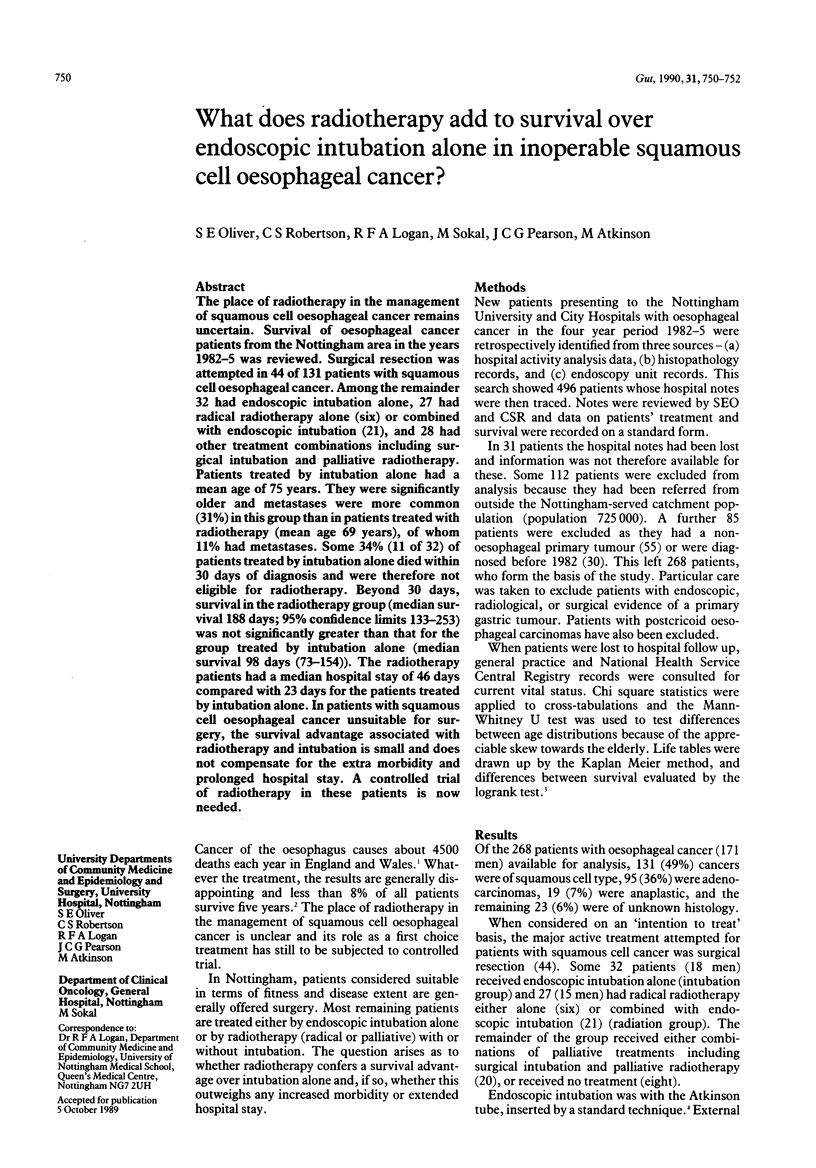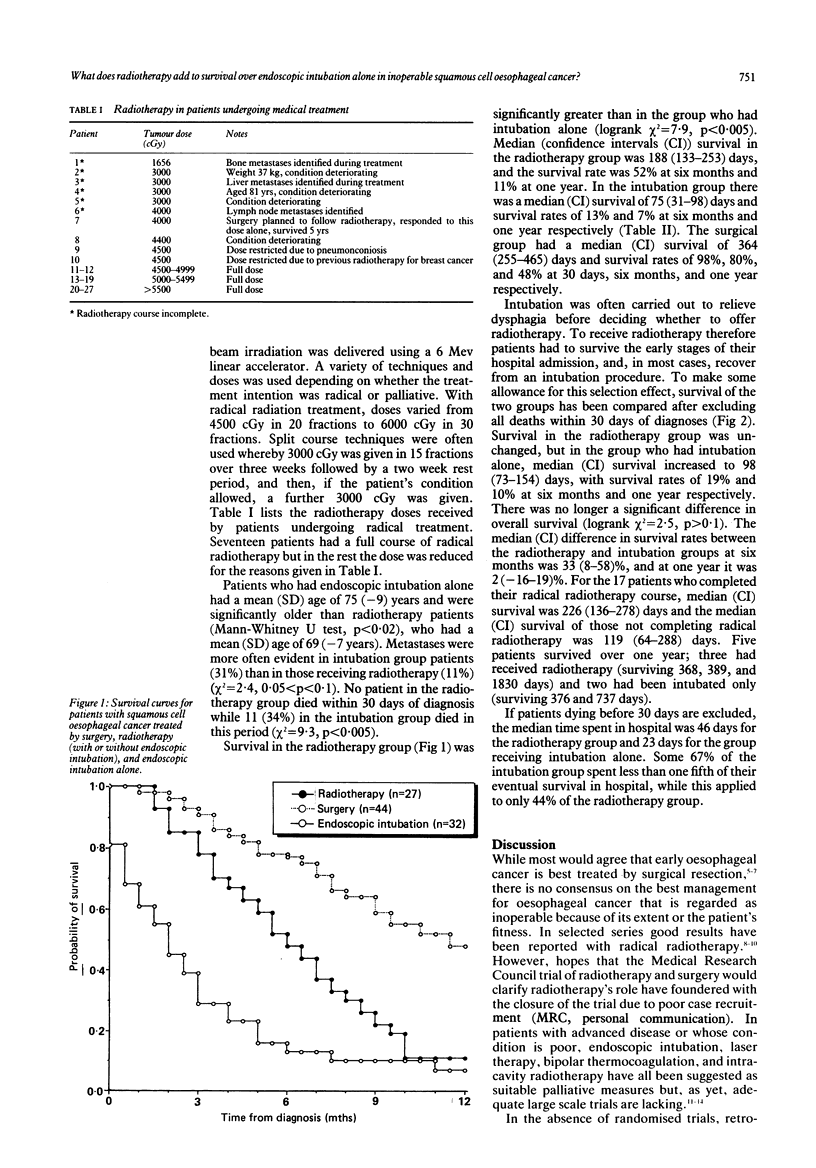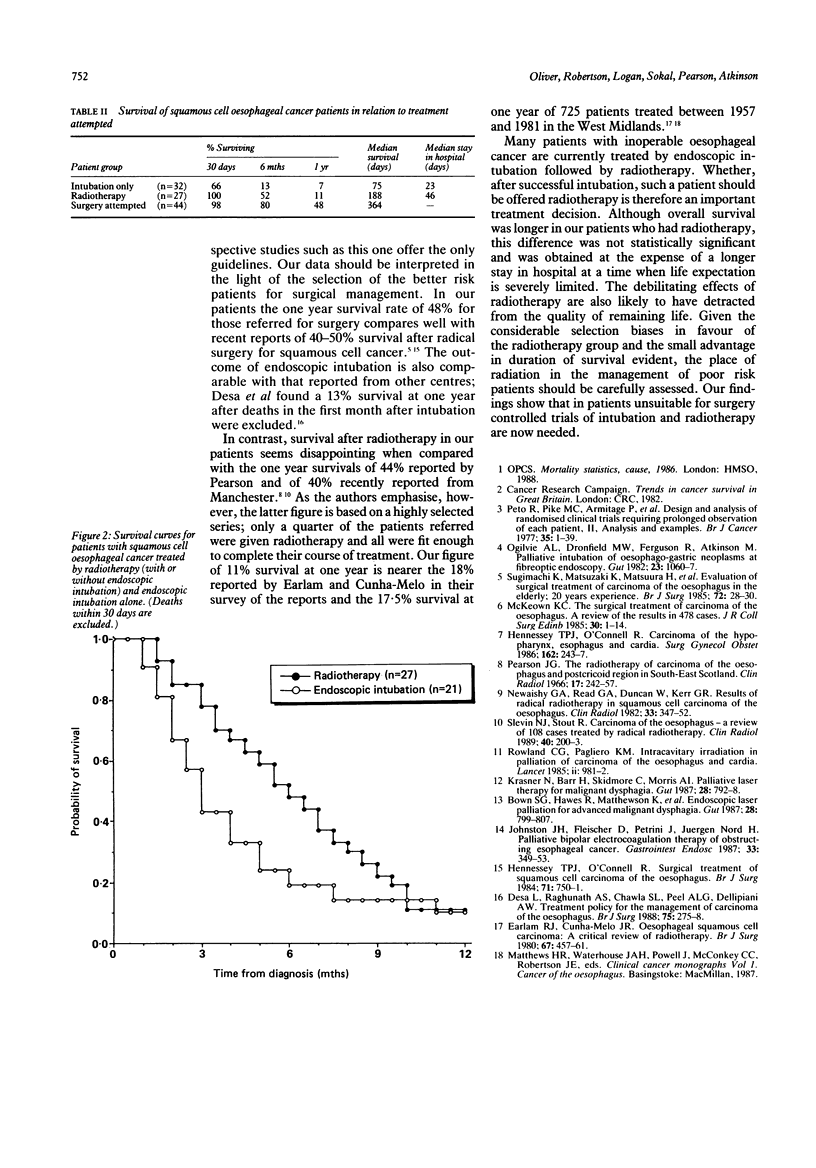Abstract
The place of radiotherapy in the management of squamous cell oesophageal cancer remains uncertain. Survival of oesophageal cancer patients from the Nottingham area in the years 1982-5 was reviewed. Surgical resection was attempted in 44 of 131 patients with squamous cell oesophageal cancer. Among the remainder 32 had endoscopic intubation alone, 27 had radical radiotherapy alone (six) or combined with endoscopic intubation (21), and 28 had other treatment combinations including surgical intubation and palliative radiotherapy. Patients treated by intubation alone had a mean age of 75 years. They were significantly older and metastases were more common (31%) in this group than in patients treated with radiotherapy (mean age 69 years), of whom 11% had metastases. Some 34% (11 of 32) of patients treated by intubation alone died within 30 days of diagnosis and were therefore not eligible for radiotherapy. Beyond 30 days, survival in the radiotherapy group (median survival 188 days; 95% confidence limits 133-253) was not significantly greater than that for the group treated by intubation alone (median survival 98 days (73-154)). The radiotherapy patients had a median hospital stay of 46 days compared with 23 days for the patients treated by intubation alone. In patients with squamous cell oesophageal cancer unsuitable for surgery, the survival advantage associated with radiotherapy and intubation is small and does not compensate for the extra morbidity and prolonged hospital stay. A controlled trial of radiotherapy in these patients is now needed.
Full text
PDF


Selected References
These references are in PubMed. This may not be the complete list of references from this article.
- Bown S. G., Hawes R., Matthewson K., Swain C. P., Barr H., Boulos P. B., Clark C. G. Endoscopic laser palliation for advanced malignant dysphagia. Gut. 1987 Jul;28(7):799–807. doi: 10.1136/gut.28.7.799. [DOI] [PMC free article] [PubMed] [Google Scholar]
- Desa L., Raghunath A. S., Chawla S. L., Peel A. L., Dellipiani A. W. Treatment policy for the management of carcinoma of the oesophagus. Br J Surg. 1988 Mar;75(3):275–278. doi: 10.1002/bjs.1800750329. [DOI] [PubMed] [Google Scholar]
- Earlam R., Cunha-Melo J. R. Oesophogeal squamous cell carcinoms: II. A critical view of radiotherapy. Br J Surg. 1980 Jul;67(7):457–461. doi: 10.1002/bjs.1800670702. [DOI] [PubMed] [Google Scholar]
- Hennessy T. P., O'Connell R. Carcinoma of the hypopharynx, esophagus and cardia. Surg Gynecol Obstet. 1986 Mar;162(3):243–247. [PubMed] [Google Scholar]
- Hennessy T. P., O'Connell R. Surgical treatment of squamous cell carcinoma of the oesophagus. Br J Surg. 1984 Oct;71(10):750–751. doi: 10.1002/bjs.1800711004. [DOI] [PubMed] [Google Scholar]
- Johnston J. H., Fleischer D., Petrini J., Nord H. J. Palliative bipolar electrocoagulation therapy of obstructing esophageal cancer. Gastrointest Endosc. 1987 Oct;33(5):349–353. doi: 10.1016/s0016-5107(87)71636-8. [DOI] [PubMed] [Google Scholar]
- Krasner N., Barr H., Skidmore C., Morris A. I. Palliative laser therapy for malignant dysphagia. Gut. 1987 Jul;28(7):792–798. doi: 10.1136/gut.28.7.792. [DOI] [PMC free article] [PubMed] [Google Scholar]
- McKeown K. C. The surgical treatment of carcinoma of the oesophagus. A review of the results in 478 cases. J R Coll Surg Edinb. 1985 Feb;30(1):1–14. [PubMed] [Google Scholar]
- Newaishy G. A., Read G. A., Duncan W., Kerr G. R. Results of radical radiotherapy of squamous cell carcinoma of the oesophagus. Clin Radiol. 1982 May 3;33(3):347–352. doi: 10.1016/s0009-9260(82)80288-2. [DOI] [PubMed] [Google Scholar]
- Ogilvie A. L., Dronfield M. W., Ferguson R., Atkinson M. Palliative intubation of oesophagogastric neoplasms at fibreoptic endoscopy. Gut. 1982 Dec;23(12):1060–1067. doi: 10.1136/gut.23.12.1060. [DOI] [PMC free article] [PubMed] [Google Scholar]
- Pearson J. G. The radiotherapy of carcinoma of the oesophagus and post cricoid region in south east Scotland. Clin Radiol. 1966 Jul;17(3):242–257. doi: 10.1016/s0009-9260(66)80030-2. [DOI] [PubMed] [Google Scholar]
- Peto R., Pike M. C., Armitage P., Breslow N. E., Cox D. R., Howard S. V., Mantel N., McPherson K., Peto J., Smith P. G. Design and analysis of randomized clinical trials requiring prolonged observation of each patient. II. analysis and examples. Br J Cancer. 1977 Jan;35(1):1–39. doi: 10.1038/bjc.1977.1. [DOI] [PMC free article] [PubMed] [Google Scholar]
- Rowland C. G., Pagliero K. M. Intracavitary irradiation in palliation of carcinoma of oesophagus and cardia. Lancet. 1985 Nov 2;2(8462):981–983. doi: 10.1016/s0140-6736(85)90527-6. [DOI] [PubMed] [Google Scholar]
- Slevin N. J., Stout R. Carcinoma of the oesophagus--a review of 108 cases treated by radical radiotherapy. Clin Radiol. 1989 Mar;40(2):200–203. doi: 10.1016/s0009-9260(89)80097-2. [DOI] [PubMed] [Google Scholar]
- Sugimachi K., Matsuzaki K., Matsuura H., Kuwano H., Ueo H., Inokuchi K. Evaluation of surgical treatment of carcinoma of the oesophagus in the elderly: 20 years' experience. Br J Surg. 1985 Jan;72(1):28–30. doi: 10.1002/bjs.1800720113. [DOI] [PubMed] [Google Scholar]


